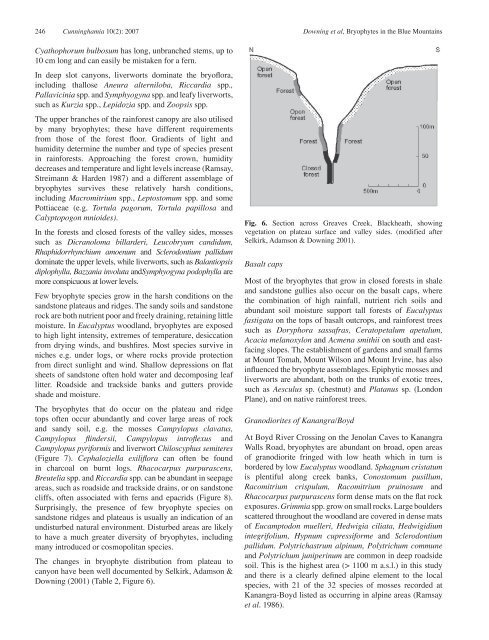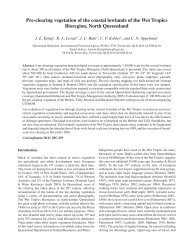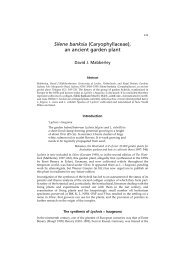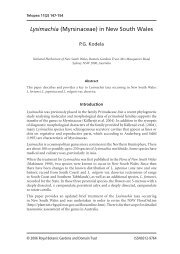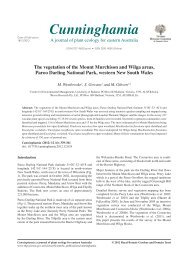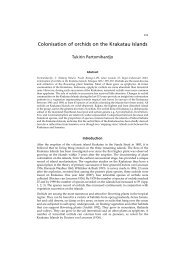Bryophytes and their distribution in the Blue Mountains region of ...
Bryophytes and their distribution in the Blue Mountains region of ...
Bryophytes and their distribution in the Blue Mountains region of ...
Create successful ePaper yourself
Turn your PDF publications into a flip-book with our unique Google optimized e-Paper software.
246 Cunn<strong>in</strong>ghamia 10(2): 2007 Down<strong>in</strong>g et al, <strong>Bryophytes</strong> <strong>in</strong> <strong>the</strong> <strong>Blue</strong> Mounta<strong>in</strong>s<br />
Cyathophorum bulbosum has long, unbranched stems, up to<br />
10 cm long <strong>and</strong> can easily be mistaken for a fern.<br />
In deep slot canyons, liverworts dom<strong>in</strong>ate <strong>the</strong> bry<strong>of</strong>lora,<br />
<strong>in</strong>clud<strong>in</strong>g thallose Aneura alterniloba, Riccardia spp.,<br />
Pallavic<strong>in</strong>ia spp. <strong>and</strong> Symphyogyna spp. <strong>and</strong> leafy liverworts,<br />
such as Kurzia spp., Lepidozia spp. <strong>and</strong> Zoopsis spp.<br />
The upper branches <strong>of</strong> <strong>the</strong> ra<strong>in</strong>forest canopy are also utilised<br />
by many bryophytes; <strong>the</strong>se have different requirements<br />
from those <strong>of</strong> <strong>the</strong> forest floor. Gradients <strong>of</strong> light <strong>and</strong><br />
humidity determ<strong>in</strong>e <strong>the</strong> number <strong>and</strong> type <strong>of</strong> species present<br />
<strong>in</strong> ra<strong>in</strong>forests. Approach<strong>in</strong>g <strong>the</strong> forest crown, humidity<br />
decreases <strong>and</strong> temperature <strong>and</strong> light levels <strong>in</strong>crease (Ramsay,<br />
Streimann & Harden 1987) <strong>and</strong> a different assemblage <strong>of</strong><br />
bryophytes survives <strong>the</strong>se relatively harsh conditions,<br />
<strong>in</strong>clud<strong>in</strong>g Macromitrium spp., Leptostomum spp. <strong>and</strong> some<br />
Pottiaceae (e.g. Tortula pagorum, Tortula papillosa <strong>and</strong><br />
Calyptopogon mnioides).<br />
In <strong>the</strong> forests <strong>and</strong> closed forests <strong>of</strong> <strong>the</strong> valley sides, mosses<br />
such as Dicranoloma billarderi, Leucobryum c<strong>and</strong>idum,<br />
Rhaphidorrhynchium amoenum <strong>and</strong> Sclerodontium pallidum<br />
dom<strong>in</strong>ate <strong>the</strong> upper levels, while liverworts, such as Balantiopsis<br />
diplophylla, Bazzania <strong>in</strong>voluta <strong>and</strong>Symphyogyna podophylla are<br />
more conspicuous at lower levels.<br />
Few bryophyte species grow <strong>in</strong> <strong>the</strong> harsh conditions on <strong>the</strong><br />
s<strong>and</strong>stone plateaus <strong>and</strong> ridges. The s<strong>and</strong>y soils <strong>and</strong> s<strong>and</strong>stone<br />
rock are both nutrient poor <strong>and</strong> freely dra<strong>in</strong><strong>in</strong>g, reta<strong>in</strong><strong>in</strong>g little<br />
moisture. In Eucalyptus woodl<strong>and</strong>, bryophytes are exposed<br />
to high light <strong>in</strong>tensity, extremes <strong>of</strong> temperature, desiccation<br />
from dry<strong>in</strong>g w<strong>in</strong>ds, <strong>and</strong> bushfires. Most species survive <strong>in</strong><br />
niches e.g. under logs, or where rocks provide protection<br />
from direct sunlight <strong>and</strong> w<strong>in</strong>d. Shallow depressions on flat<br />
sheets <strong>of</strong> s<strong>and</strong>stone <strong>of</strong>ten hold water <strong>and</strong> decompos<strong>in</strong>g leaf<br />
litter. Roadside <strong>and</strong> trackside banks <strong>and</strong> gutters provide<br />
shade <strong>and</strong> moisture.<br />
The bryophytes that do occur on <strong>the</strong> plateau <strong>and</strong> ridge<br />
tops <strong>of</strong>ten occur abundantly <strong>and</strong> cover large areas <strong>of</strong> rock<br />
<strong>and</strong> s<strong>and</strong>y soil, e.g. <strong>the</strong> mosses Campylopus clavatus,<br />
Campylopus fl<strong>in</strong>dersii, Campylopus <strong>in</strong>tr<strong>of</strong>lexus <strong>and</strong><br />
Campylopus pyriformis <strong>and</strong> liverwort Chiloscyphus semiteres<br />
(Figure 7). Cephaloziella exiliflora can <strong>of</strong>ten be found<br />
<strong>in</strong> charcoal on burnt logs. Rhacocarpus purpurascens,<br />
Breutelia spp. <strong>and</strong> Riccardia spp. can be abundant <strong>in</strong> seepage<br />
areas, such as roadside <strong>and</strong> trackside dra<strong>in</strong>s, or on s<strong>and</strong>stone<br />
cliffs, <strong>of</strong>ten associated with ferns <strong>and</strong> epacrids (Figure 8).<br />
Surpris<strong>in</strong>gly, <strong>the</strong> presence <strong>of</strong> few bryophyte species on<br />
s<strong>and</strong>stone ridges <strong>and</strong> plateaus is usually an <strong>in</strong>dication <strong>of</strong> an<br />
undisturbed natural environment. Disturbed areas are likely<br />
to have a much greater diversity <strong>of</strong> bryophytes, <strong>in</strong>clud<strong>in</strong>g<br />
many <strong>in</strong>troduced or cosmopolitan species.<br />
The changes <strong>in</strong> bryophyte <strong>distribution</strong> from plateau to<br />
canyon have been well documented by Selkirk, Adamson &<br />
Down<strong>in</strong>g (2001) (Table 2, Figure 6).<br />
Fig. 6. Section across Greaves Creek, Blackheath, show<strong>in</strong>g<br />
vegetation on plateau surface <strong>and</strong> valley sides. (modified after<br />
Selkirk, Adamson & Down<strong>in</strong>g 2001).<br />
Basalt caps<br />
Most <strong>of</strong> <strong>the</strong> bryophytes that grow <strong>in</strong> closed forests <strong>in</strong> shale<br />
<strong>and</strong> s<strong>and</strong>stone gullies also occur on <strong>the</strong> basalt caps, where<br />
<strong>the</strong> comb<strong>in</strong>ation <strong>of</strong> high ra<strong>in</strong>fall, nutrient rich soils <strong>and</strong><br />
abundant soil moisture support tall forests <strong>of</strong> Eucalyptus<br />
fastigata on <strong>the</strong> tops <strong>of</strong> basalt outcrops, <strong>and</strong> ra<strong>in</strong>forest trees<br />
such as Doryphora sassafras, Ceratopetalum apetalum,<br />
Acacia melanoxylon <strong>and</strong> Acmena smithii on south <strong>and</strong> eastfac<strong>in</strong>g<br />
slopes. The establishment <strong>of</strong> gardens <strong>and</strong> small farms<br />
at Mount Tomah, Mount Wilson <strong>and</strong> Mount Irv<strong>in</strong>e, has also<br />
<strong>in</strong>fluenced <strong>the</strong> bryophyte assemblages. Epiphytic mosses <strong>and</strong><br />
liverworts are abundant, both on <strong>the</strong> trunks <strong>of</strong> exotic trees,<br />
such as Aesculus sp. (chestnut) <strong>and</strong> Platanus sp. (London<br />
Plane), <strong>and</strong> on native ra<strong>in</strong>forest trees.<br />
Granodiorites <strong>of</strong> Kanangra/Boyd<br />
At Boyd River Cross<strong>in</strong>g on <strong>the</strong> Jenolan Caves to Kanangra<br />
Walls Road, bryophytes are abundant on broad, open areas<br />
<strong>of</strong> granodiorite fr<strong>in</strong>ged with low heath which <strong>in</strong> turn is<br />
bordered by low Eucalyptus woodl<strong>and</strong>. Sphagnum cristatum<br />
is plentiful along creek banks, Conostomum pusillum,<br />
Racomitrium crispulum, Racomitrium pru<strong>in</strong>osum <strong>and</strong><br />
Rhacocarpus purpurascens form dense mats on <strong>the</strong> flat rock<br />
exposures. Grimmia spp. grow on small rocks. Large boulders<br />
scattered throughout <strong>the</strong> woodl<strong>and</strong> are covered <strong>in</strong> dense mats<br />
<strong>of</strong> Eucamptodon muelleri, Hedwigia ciliata, Hedwigidium<br />
<strong>in</strong>tegrifolium, Hypnum cupressiforme <strong>and</strong> Sclerodontium<br />
pallidum. Polytrichastrum alp<strong>in</strong>um, Polytrichum commune<br />
<strong>and</strong> Polytrichum juniper<strong>in</strong>um are common <strong>in</strong> deep roadside<br />
soil. This is <strong>the</strong> highest area (> 1100 m a.s.l.) <strong>in</strong> this study<br />
<strong>and</strong> <strong>the</strong>re is a clearly def<strong>in</strong>ed alp<strong>in</strong>e element to <strong>the</strong> local<br />
species, with 21 <strong>of</strong> <strong>the</strong> 32 species <strong>of</strong> mosses recorded at<br />
Kanangra-Boyd listed as occurr<strong>in</strong>g <strong>in</strong> alp<strong>in</strong>e areas (Ramsay<br />
et al. 1986).


